Grace Elliot's Blog: 'Familiar Felines.' , page 25
February 6, 2012
The Great Seducers - The Siren
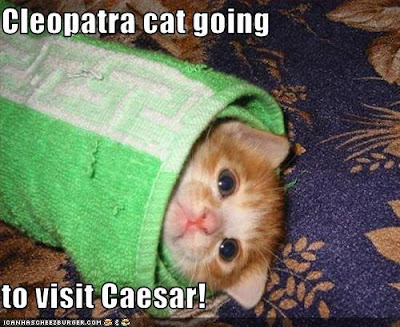
At the heart of romance lies a game of attraction - which some people play better than others. And the most successful at getting their heart's desire, are those people gifted in the art of seduction.
Throughout history seducers have been central to some of the greatest love stories, and my next few blog posts will consider famous seducers from history and ponder their talents.
 See the end of this post for giveaway details and blog hop links.There are 9 types of seducers:
See the end of this post for giveaway details and blog hop links.There are 9 types of seducers:- Siren Alight with a sexual energy that transcends beauty. - Rake Adores the opposite sex and his desire is infectious.- Ideal Lover A sensitivity applied to romance-Dandy Plays with his own image to create allure-Natural Spontaneous and open.-Coquette Desire to be admired and yet distances herself.-Charmers Knows how to please-Charismatic Possess an unusual self confidence that attracts people-Star Seemingly unobtainable and enveloped in mystery.
Arguably the most famous siren of all time was the Eygptian queen, Cleopatra.
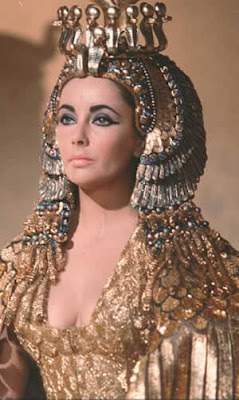
A siren learns how to take control by embodying the male fantasy. In male dominated society, this is one of the few ways a woman had of exerting influence. In Cleopatra's case, although she was a queen, to gain his protection she needed to manipulate one of the most powerful men in the world, Caesar. Not only that but Caesar had had numerous mistresses in the past, whom he quickly grew bored of, to return to what really motivated him - politics and warfare.
So how was Cleopatra different?
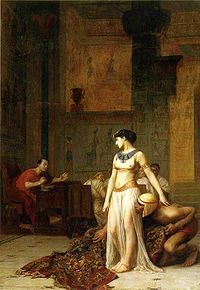
To start with she was daring, which appealed to the soldier in Caesar. She was smuggled into his chamber in a carpet, with only one man to protect her. "Cleopatra was in the prime of life. She had a delightful voice which cound not fail to cast a spell over all who heard it....Caesar was spellbound as soon as he set eyes on her and she opened her mouth to speak." Dio Cassius, Roman writer.
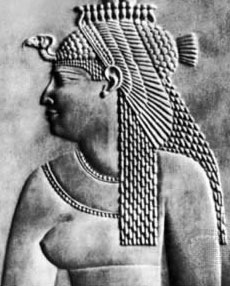
She seduced the Roman leader by speaking of reviving the glory of Alexander the Great and how together, they could rule the world like gods. She dressed as the goddess Isis, and surrounded Caesar by decadent opulence and yet when he felt secure with her attention she would turn cold or angry, such that just as if fighting a battle, he had to find a strategm to win her over.
But more than that, when Caesar was murdered in 44 BC, Cleopatra used her power and personal charm to seduce the new ruler, Mark Antony. "The charm of [Cleopatra's] presence was irresistible, and there was an attraction in her person and talk, together with a perculiar force of character, which pervaded her every word and action, and laid all who associated with it hereunder its spell."
Did you notice how, in the above quote, she is not described beautiful - but the force of her character, her energy and actions are the source of her attractiveness. In Mark Antony's case, he wanted to possess this intriguing woman in order to prove how powerful he was - something Cleopatra used to her own advantage.
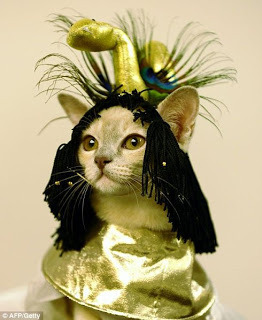
So what makes a siren? Not necessarily physical beauty. Again, Cleopatra's allure seems to have been in the theatre she created around herself, how her make up and costume changed each day to keep people entranced. She kept her admirer's guessing, never let them feel on safe ground but always working to please her. What she realised was that by using sheer physical presence, her admirers could not grow bored and neither would they see who she really was.
"We're dazzled by the feminine adornment, by the surface,All gold and jewels: so little of what we observe, is the girl herself.Can the object of our passion be found?They eye's deceived by love's smart camouflage." Ovid. Some called Cleopatra a whore, for doing what she did, others called it political cunning. I suspect she was merely trying to survive in very dangerous times. What do you think? Was Cleopatra to be applauded for beating men at their own game, or vilified for loose morals? Was she right or wrong to use the talents at her disposal?Do comment, I'd love to know your thoughts.
(NEXT WEEK: The Rake.)Please follow the link to complete the blog hop:http://iamareadernotawriter.blogspot.com/2011/12/follower-love-giveaway-hop-sign-ups.html

Grace is offering one lucky person an ebook copy of either A Dead Man's Debt, Eulogy's Secret or Cat Pies, to one lucky person who either :-starts following her on Twitter - @grace_elliotOR-joins this blogOR -Likes Grace's FB page: http://www.facebook.com/pages/Grace-Elliot/173092742739684?v=wall&sk=wallThen leave your email address in the comments below; The winner will be notified on February 15th.
Published on February 06, 2012 14:25
February 1, 2012
"Deeds Not Words."

With the American primaries constantly in the headlines, even here in the UK, it made me think about the importance of democracy and voting, and so this week's blog post is the controversial story of Emily Davison, and her fight to win the votes for women.
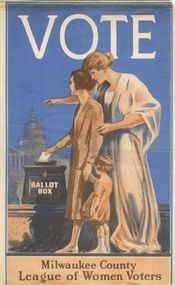
In Britain a hundred years ago most men thought women couldn't understand how Parliament worked and therefore they were not allowed to vote. So in 1897 Millicent Fawcett started a peaceful campaign for 'Votes For Women'. In 1903 a more militant organisation, known as the 'Suffragettes' was created by Emmeline Pankhurst.
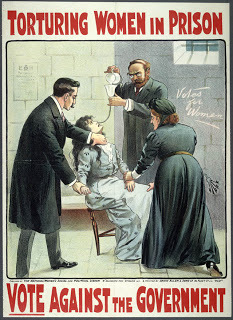
The Suffragettes were savvy about getting attention, which eventually ended in tragedy for Emily Davison.
In Edwardian Britain, Emily Davison was a woman ahead of her time; she defied convention in a male dominated society and graduated from London University, and then went on to study at Oxford, where she gained a first class honours degree. But Emily was angered by inequalities she saw around her and was determined to do something about it.
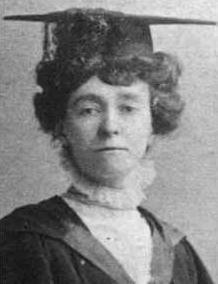 Emily Davison - circa 1913To get publicity for the cause of women's suffrage, Emily ran onto the race track during the 1913 Epsom Derby, and threw herself at the king's horse, Anmer. Tragically, she was trampled and died of her injuries.
Emily Davison - circa 1913To get publicity for the cause of women's suffrage, Emily ran onto the race track during the 1913 Epsom Derby, and threw herself at the king's horse, Anmer. Tragically, she was trampled and died of her injuries.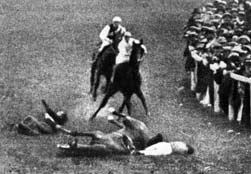 The fateful moment Emily brings down the king's horse.The Suffragette's claimed Emily as the first martyr to their cause and later Emmeline Pankhurst wrote that Emily had decided only the loss of life would:
The fateful moment Emily brings down the king's horse.The Suffragette's claimed Emily as the first martyr to their cause and later Emmeline Pankhurst wrote that Emily had decided only the loss of life would:"...put an end to the intolerable torture of women."
In tribute to Emily's belief in votes for women, her gravestone was inscribed:
"Deeds Not Words."
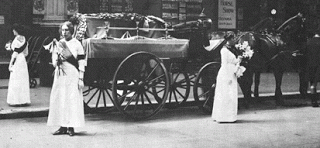 Emily's coffin escorted by Suffragettes.In reality Emily Davison's death so horrified the politicians that they argued if an educated woman such as Emily, could act to irrationally, what bedlam would British society be plunged into if less educated women were allowed the vote?
Emily's coffin escorted by Suffragettes.In reality Emily Davison's death so horrified the politicians that they argued if an educated woman such as Emily, could act to irrationally, what bedlam would British society be plunged into if less educated women were allowed the vote? 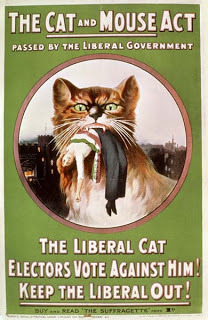 The Cat and Mouse Act - brought in to deal with Suffragette's on hunger strike.However, not everyone agreed Emily intended to kill herself and some argued that Emily's death was actually an accident. The royal jockey, Herbert Jones made it known that he didn't think Emily meant to harm herself. He was haunted by the look of surprise seconds before the collision. His theory was that because of the deceptive undulations of the race track, Emily assumed all the horses had passed and merely intended to run onto the track to protest and draw attention, but a dip hid a bunch of stragglers, including his mount - with fatal consequences.
The Cat and Mouse Act - brought in to deal with Suffragette's on hunger strike.However, not everyone agreed Emily intended to kill herself and some argued that Emily's death was actually an accident. The royal jockey, Herbert Jones made it known that he didn't think Emily meant to harm herself. He was haunted by the look of surprise seconds before the collision. His theory was that because of the deceptive undulations of the race track, Emily assumed all the horses had passed and merely intended to run onto the track to protest and draw attention, but a dip hid a bunch of stragglers, including his mount - with fatal consequences.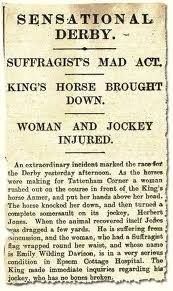
The question of whether Emily meant to kill herself was recently raised again when in 1986 some personal papers kept by the Davison's family solicitor came to light. Amongst Emily's personal effects was a return rail ticket from Epsom to Victoria, which would suggest she intended to go home that night…
"Deeds Not Words."
Do you always use your vote? Is voting important to you?

Published on February 01, 2012 10:25
January 25, 2012
Vandals and Thieves - The Crown Jewels (part 2 of 2)
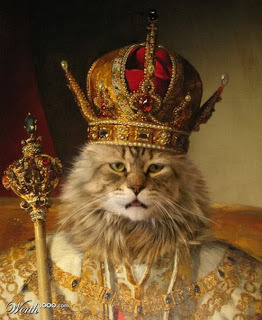
During the turbulence of the English Civil War, (1640's), Charles I had the gold and silver plate used in ceremonial banquets smuggled out of the Tower and melted down to bolster his depleted finances. When Oliver Cromwell eventually seized power he had what remained of the crown jewels melted down as symbols of:
"The detestable rule of kings".
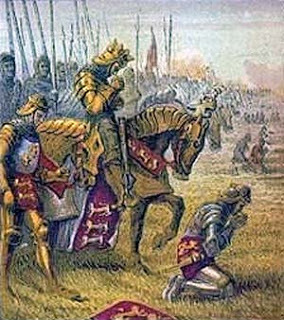 Henry V prays before the battle of Agincourt.
Henry V prays before the battle of Agincourt.The precious metals were minted into Cromwell's Commonwealth coinage, but in the process many precious artefacts were destroyed. Two ancient Saxon crowns, reputedly worn by King Alfred the Great and Queen Edith were consigned to the furnace, and to their credit MPs protested at the time that this was wanton vandalism - but to no avail.
A handful of artefacts were saved by monks who hid items such as a coronation anointing spoon, the Black Prince's ruby (worn in Henry V's helmet at Agincourt and reputed to have deflected a near fatal blow to the head) and a silver salt cellar belong to Elizabeth I, were saved.
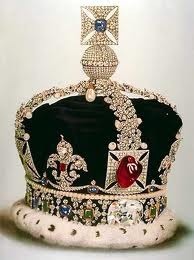 Centre piece - The Black Prince's Ruby.
Centre piece - The Black Prince's Ruby.Much later, with the monarchy restored, some of the gems were recovered and mounted in a third set of Crown Jewels, ready for Charles II coronation in 1661. The Black Prince's ruby was one of these stones - which had apparently been sold for just four pounds, a derisory sum even at the time. The jewel was mounted in the new king's state crown by, Sir Robert Vyner, court jeweller. In the name of continuity Vyner was instructed to make the new jewels as close to the original as possible - work which cost an eye-watering 32,000 pounds.
Celebrated Jewel Thief.However such profligacy didn't go unnoticed by a man known to posterity as Colonel Thomas Blood (although he never rose above the rank of Lieutenant).
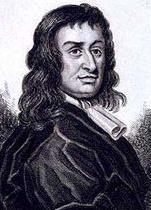 'Colonel' Thomas Blood.Born in Ireland, in 1618, Blood refused to accept the return of the monarchy and was active in many Republican plots. In the 1660's he even tried to storm the Tower, and through good luck got away scot free. An adventurer in the truest sense of the word, Blood went on to rescue a co-conspirator, Captain John Mason, as he was moved to York for trial and execution, and attempted the abduction of the Duke of Ormonde.
'Colonel' Thomas Blood.Born in Ireland, in 1618, Blood refused to accept the return of the monarchy and was active in many Republican plots. In the 1660's he even tried to storm the Tower, and through good luck got away scot free. An adventurer in the truest sense of the word, Blood went on to rescue a co-conspirator, Captain John Mason, as he was moved to York for trial and execution, and attempted the abduction of the Duke of Ormonde. 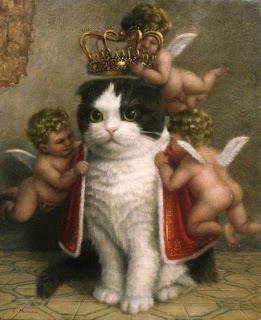
But it was Blood's audacious plan in 1671 that he is remembered for: stealing the crown jewels. Dressed as a cleric and accompanied by a woman he described as his 'wife', Blood bribed the Assistant Keeper of the Jewels, Talbot Edwards, to let them view the jewels. Having gained access to the jewel room Blood's wife fainted and Edwards went to fetch a glass of water, thus leaving Blood alone to case the joint. After that, a series of visits then took place where Blood 'groomed' Edwards and gained his confidence. When Blood returned with two friends to view the jewels, Edwards smelt trouble and in the ensuing struggle was stabbed in the stomach with a long knife.
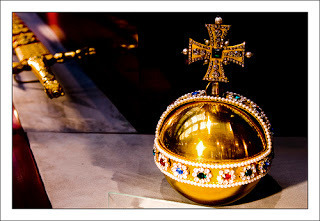 The Sovereign's Orb - hidden by Blood's conspirator in his trousers! The thieves had thought of every detail; Blood carried a mallet to hammer the St Edward's crown flat and then conceal it under his clothes, another conspirator hid the Sovereign's Orb down his trousers and the other cut the Sceptre with the Cross in half. However it was at this moment that Edwards' son returned to visit and seeing the crime in progress, tried to apprehend the villains. The cry was raised,
The Sovereign's Orb - hidden by Blood's conspirator in his trousers! The thieves had thought of every detail; Blood carried a mallet to hammer the St Edward's crown flat and then conceal it under his clothes, another conspirator hid the Sovereign's Orb down his trousers and the other cut the Sceptre with the Cross in half. However it was at this moment that Edwards' son returned to visit and seeing the crime in progress, tried to apprehend the villains. The cry was raised,"Treason! Murder! The crown is stolen!"
The thieves were eventually caught by guards as, weighted down with loot, they passed under the archway of the Bloody Tower.
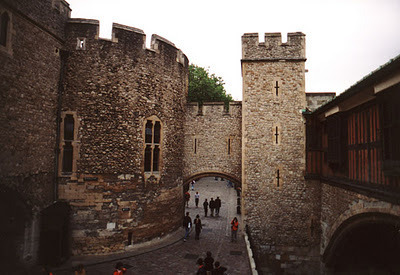 Laiden with swag Blood nearly escaped under the Bloody TowerColonel Blood and his gang were imprisoned in the vaults beneath the White Tower to await the king's pleasure and since theft of the royal jewels was akin to kidnapping the monarch himself, a sentence of being hung, drawn and quartered was expected.
Laiden with swag Blood nearly escaped under the Bloody TowerColonel Blood and his gang were imprisoned in the vaults beneath the White Tower to await the king's pleasure and since theft of the royal jewels was akin to kidnapping the monarch himself, a sentence of being hung, drawn and quartered was expected. However the plot thickens because Charles II was astonishingly lenient and rather than punishing Blood, the felon was awarded a pension of 500 pounds a year. Rumours started that Blood was actually acting for Charles to raise much needed cash…
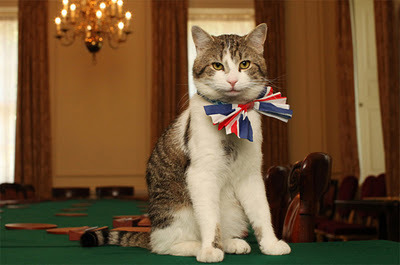 Larry - the Downing Street cat - suitably attired for the recent Royal Wedding
Larry - the Downing Street cat - suitably attired for the recent Royal Wedding
Published on January 25, 2012 08:57
January 18, 2012
Royal Dismeanours - The Crown Jewels (part I)
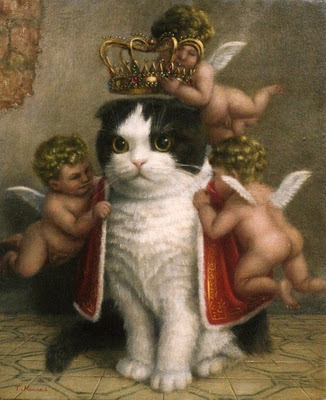
King John, of Robin Hood fame, a contender for the title of "Worst King of England" is attributed with losing the first set of crown jewels in the Wash 1216. (The Wash is an area of wetlands on the East coast of England, and nothing to do with personal hygiene.) This isnt quite as strange as it sounds because Medieval kings were constantly on the move about their kingdom and took their jewels with them, to impress the locals with their wealth and authority.
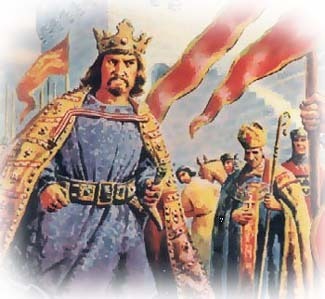 King John - also known as "John Softsword" after going back on his word.The story of the crown jewels loss is connected to John trying to cross the tidal marshes with a baggage train containing his valuables. Surprised by the speed of the incoming tide, the wagons became bogged down in quicksand.
King John - also known as "John Softsword" after going back on his word.The story of the crown jewels loss is connected to John trying to cross the tidal marshes with a baggage train containing his valuables. Surprised by the speed of the incoming tide, the wagons became bogged down in quicksand. The Wash estuary.Charles Dickens gives us an account of events in his "A Child's History of England."
The Wash estuary.Charles Dickens gives us an account of events in his "A Child's History of England.""…Looking back from the shore when he was safe, he [The King] saw the water sweeping down in a torrent, overturn the wagons, horses and men that carried his treasure and engulf them in a raging whirlpool from which nothing could be recovered."
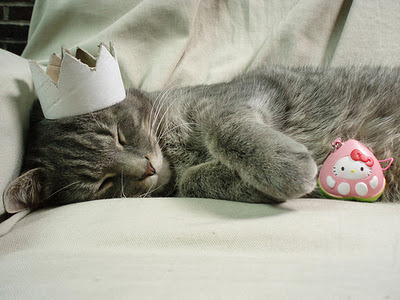
This was the beginning of the end for John, who, overcome with the magnitude of the personal disaster was taken to a nearby monastery where he drowned his sorrows with large quantities of pear cider, developed dysentery and died!
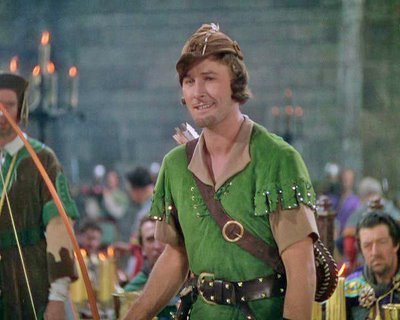 Early Hollywood portrayal of Robin Hood.
Early Hollywood portrayal of Robin Hood.With John dead, his son, the new King Henry was crowned but he had to make do with a simple gold circlet instead of a crown. This lack of finery was perhaps the beginning of Henry III's interest in jewels and royal symbols of power. By 1230 he decided the core of his jewels - the royal crown, orb and sceptre - symbols of the monarch's temporal and spiritual power, should be kept under guard in the Tower of London. Thus began the beginning of the Tower's link to the crown jewels
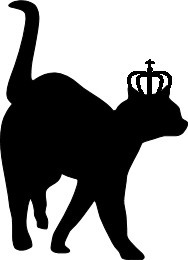
Henry III had his own problems and had to put the crown jewels to work, in a different way to his father. Constantly in need of money, not least for continual building work on the Tower, he pawned the gold and precious stones to a group of French merchants. When he died in 1272, they had to be hastily redeemed and brought back to England for the coronation of his son and successor, Edward I.
The First Plantagenets.
Henry II (married Eleanor of Aquitaine) R 1154 - 1189Richard (the Lionheart - of Robin Hood legend.) R 1189 - 1199John (signed the Magna Carta in 1215 to placate his barons.) R 1199 - 1216Henry III R 1216 - 1272Edward I R 1272 - 1307Et.c
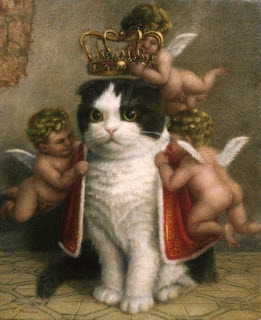
NEXT post…Who melted down the second set of crown jewels and which King discovered he was wearing fake jewels?
Published on January 18, 2012 08:45
January 11, 2012
London Bridge Legends.

I have no sense of direction. Many, many times my total lack of direction has got me into trouble, such as the time I went the wrong way round the M25 and a journey that should have taken quarter of an hour, took 90 minutes. And last summer, I decided to take my son to the Museum of London, only to end up at the London Docklands Museum (a subtle but essential difference, which meant we ended up at completely the wrong place!) However, in this case all ended well since the Dockland museum was fascinating and has inspired today's blog post on: London Bridge.
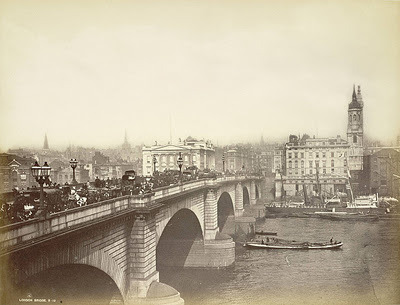 London Bridge in the 1800's. It is not my intention to give a history of this historic landmark, but more a mention of some of the lesser known legends associated with it. It is thought that a bridge first spanned the Thames in the site of the current London Bridge, in Roman times. The first stone bridge was erected around 1136 and on this more permanent structure, people started to build houses.
London Bridge in the 1800's. It is not my intention to give a history of this historic landmark, but more a mention of some of the lesser known legends associated with it. It is thought that a bridge first spanned the Thames in the site of the current London Bridge, in Roman times. The first stone bridge was erected around 1136 and on this more permanent structure, people started to build houses. 
The nursery rhyme "London Bridge is falling down," has ensured the bridge is one of the most famous in the English language, but the origin of rhyme is unknown. The first written mention of it is in 1766 and Tommy Thumb's Pretty Song Book.
London Bridge is falling down,
Falling down, falling down.
London Bridge is falling down,
My fair lady
Build it up with wood and clay,
Wood and clay, wood and clay,
Build it up with wood and clay,
My fair lady.
Wood and clay will wash away,
Wash away, wash away,
Wood and clay will wash away,
My fair lady.
Build it up with bricks and mortar,
Bricks and mortar, bricks and mortar,
Build it up with bricks and mortar,
My fair lady.Et.c
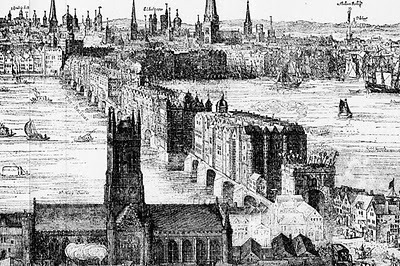 London Bridge 1616One theory is that it refers to the different attempts to build a bridge over the Thames; how wood rotted over time, and burning during the Great Fire of London. A more grizzly suggestion is that the song is associated with burying things, possible children, in the foundations of the bridge to ensure good luck. Fortunately, there is no archaeological evidence to back up the later.
London Bridge 1616One theory is that it refers to the different attempts to build a bridge over the Thames; how wood rotted over time, and burning during the Great Fire of London. A more grizzly suggestion is that the song is associated with burying things, possible children, in the foundations of the bridge to ensure good luck. Fortunately, there is no archaeological evidence to back up the later. 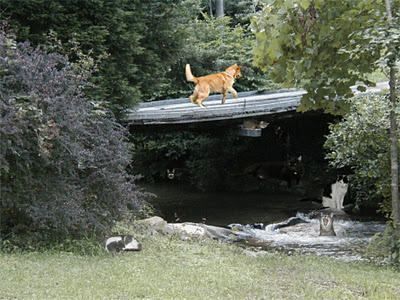
So who is the "Fair Lady" mentionned in the rhyme?
There are three main contenders: - Matilda of Scotland - (1080 - 1118) - consort of King Henry I, who was responsible for building a series of bridges across streams between Bow and Stratford.- Eleanor of Provence (1223 -91) , consort of Henry III who was custodian of bridge revenues from 1269 to 1281 -A member of the aristocratic Leigh family, from Warwickshire, who had a family tradition that a human sacrifice lies under their family home at Stoneleigh Park.
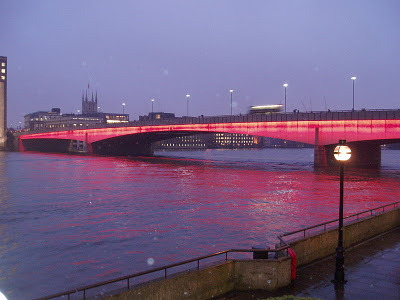 The current London Bridge (often confused with Tower Bridge!) On a more cheery note, another legend associated with London Bridge is that of the Swaffham Pedlar. He had a dream in which he was told that someone on the bridge would tell him joyous news. With this in mind he went there and waited for three days and nights. Eventually a shopkeeper went out and asked the pedlar what he was doing. When he explained his errand the shopkeeper laughed and said:
The current London Bridge (often confused with Tower Bridge!) On a more cheery note, another legend associated with London Bridge is that of the Swaffham Pedlar. He had a dream in which he was told that someone on the bridge would tell him joyous news. With this in mind he went there and waited for three days and nights. Eventually a shopkeeper went out and asked the pedlar what he was doing. When he explained his errand the shopkeeper laughed and said:"I myself have had a dream that if I went to a particular oak tree in Swaffham, and dug underneath it, there I would find great treasure, but I am not such a fool as to follow dreams."
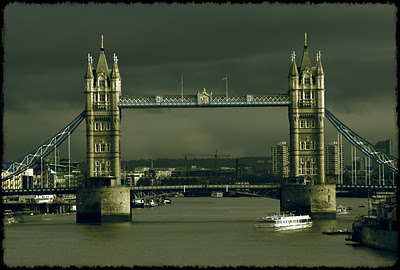 Tower Bridge (often mistakenly called, London Bridge.)The pedlar thanked him and left. He proceeded home to dig under the oak tree, only to unearth a pot of gold! Some versions add that a visitor to the now wealthy man read a Latin inscription on the pot that translates as:
Tower Bridge (often mistakenly called, London Bridge.)The pedlar thanked him and left. He proceeded home to dig under the oak tree, only to unearth a pot of gold! Some versions add that a visitor to the now wealthy man read a Latin inscription on the pot that translates as:"Under me doth lie, Another much richer than I."
He went and dug in the same spot, to discover even more treasure!

So there we have it - a blog post inspired by an accidental trip to a museum I had no idea existed. Do you have 'happy accidents' or am I the only one with a talent for getting lost?
Published on January 11, 2012 09:20
January 4, 2012
Reasons To Be Cheerful - January!
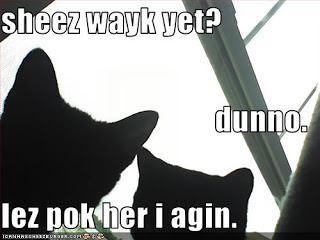
Hello and welcome to my first post of 2012! (Drums fingers and stares at the ceiling for inspiration.) The trouble is we may have a brand, New Year - but the weather is still damp, dull and grey. So to cheer everybody up lets take a look at what traditions January holds in store.
 6 January - The Epiphany or Twelfth Night (or time to take the decorations down!)
6 January - The Epiphany or Twelfth Night (or time to take the decorations down!)Whether you want to call 6th January, Epiphany or Twelfth night (more of the differences shortly) this is the last day for taking your Christmas decorations down. Epiphany is the easier of the two to explain. Named after the Greek word for 'manifestation' it was first celebrated as the day of Christ's baptism and took another four centuries to become associated with the visit of the Magi or Three Wise King's to the infant Jesus. Twelfth Night came about in AD 567 when the Council of Tours decreed that the duration of the Christmas festival would be 12 days, during which time no one should be made to work!
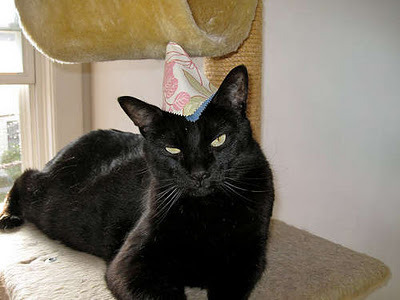 Party animal.Originally, Twelfth Night was marked with a massive party. From the reign of Charles II through to George II, in England the day was marked with masques, plays, pageants and gifts. Those with less money played games involving role play at being the King or Queen. To this end players shared a cake containing a bean, pea and clove. The bean represented the king, pea the queen and clove the knave. Whoever found the respective legume in his slice got to play that part. Samuel Pepys mentioned a Twelfth cake in his diary, when drew the clove and secretly placed it into his neighbour's portion! Sadly the fun part of Twelfth night seems to have died out, leaving us instead with a slightly sad day when all the fun and sparkle of Christmas disappears. So what can we look forward to?
Party animal.Originally, Twelfth Night was marked with a massive party. From the reign of Charles II through to George II, in England the day was marked with masques, plays, pageants and gifts. Those with less money played games involving role play at being the King or Queen. To this end players shared a cake containing a bean, pea and clove. The bean represented the king, pea the queen and clove the knave. Whoever found the respective legume in his slice got to play that part. Samuel Pepys mentioned a Twelfth cake in his diary, when drew the clove and secretly placed it into his neighbour's portion! Sadly the fun part of Twelfth night seems to have died out, leaving us instead with a slightly sad day when all the fun and sparkle of Christmas disappears. So what can we look forward to?
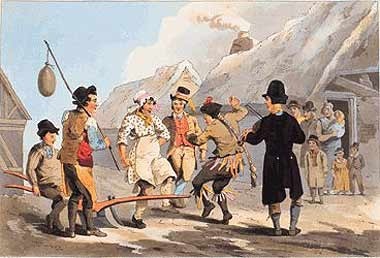 A plough being taken through the streets to raise money.Plough Monday. Plough Monday was the first Monday after Twelfth night and widely regarded as the start of the agricultural year. In 15th century England there are references to Plough Lights being lit in churches, these candles were kept burning to bring God's blessing on the farmers' efforts. But then things become a bit blurry, because some parishes formed 'plough guilds' to raise money to pay for the candles, and then raising money became an end in itself with ploughs being taken round from church to church for fund-raising purposes. With the Reformation plough lights were banned as superstitious and the practice died out.
A plough being taken through the streets to raise money.Plough Monday. Plough Monday was the first Monday after Twelfth night and widely regarded as the start of the agricultural year. In 15th century England there are references to Plough Lights being lit in churches, these candles were kept burning to bring God's blessing on the farmers' efforts. But then things become a bit blurry, because some parishes formed 'plough guilds' to raise money to pay for the candles, and then raising money became an end in itself with ploughs being taken round from church to church for fund-raising purposes. With the Reformation plough lights were banned as superstitious and the practice died out. 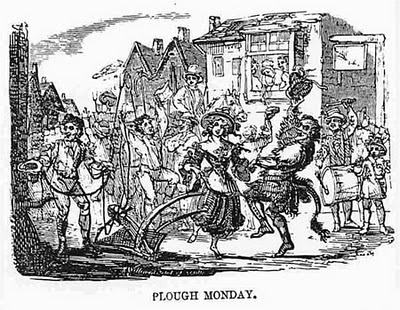 Saints Days.
Saints Days. There are a whole crop of Saints days to look forward to in January (tongue firmly in cheek) :
7th - St Distaff's Day (when women started spinning again, after Christmas)13th -St Hilary's Day - reputedly the coldest day of the year.19th -St Wulfstan's Day - a popular medieval saint, now largely ignored21st -St Agnes' Day - young women could divine their future husbands on this eve.22nd -St Vincent's' Day - if the sun shines today, the weather will be fair for the year.25th -St Paul's Day - if the weather is good here, a great harvest could be expected.
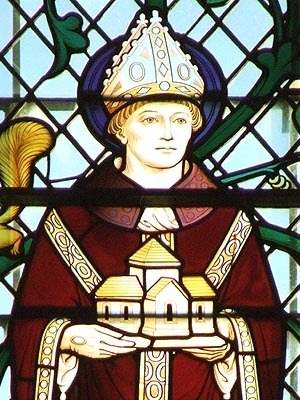 St Wulfstan - who bizarrely has a cheese named in his honour. Now, if that isn't enough to make January more interesting, here is one final piece of trivia. The anniversary of the execution of King Charles I falls on January 30th. Charles was beheaded on 30 January 1649 - sending shock waves through English society. Reputedly, Charles had a favourite black cat called "Lucky" that kept him company whilst in prison. On the morning of the King's execution Lucky went missing….
St Wulfstan - who bizarrely has a cheese named in his honour. Now, if that isn't enough to make January more interesting, here is one final piece of trivia. The anniversary of the execution of King Charles I falls on January 30th. Charles was beheaded on 30 January 1649 - sending shock waves through English society. Reputedly, Charles had a favourite black cat called "Lucky" that kept him company whilst in prison. On the morning of the King's execution Lucky went missing….
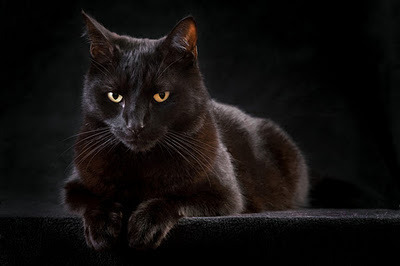 Lucky...or unlucky for Charles?You may or may not have gathered, that January isn't my favourite time of year - far too dismal for my liking. But how about you? Is it a good or bad time of year? Please leave a comment to cheer me up.
Lucky...or unlucky for Charles?You may or may not have gathered, that January isn't my favourite time of year - far too dismal for my liking. But how about you? Is it a good or bad time of year? Please leave a comment to cheer me up.
Published on January 04, 2012 08:12
December 29, 2011
New Year - A new take on an old custom?

Did you know, in the UK, New Year's Day was only declared a public holiday in 1974?
 Giveaway blog hop! For a chance to win an ebook copy of either "Eulogy's Secret" or "Cat Pies" simply follow the link and "like" my FB author page,http://www.facebook.com/pages/Grace-Elliot/173092742739684?v=wall&sk=wall and leave a comment below. Please state your prefered book and leave an email address.Good luck!******Rich with the symbolism of the old year passing and welcoming the new, it seems right to see the New Year in - as a time for fresh starts and resolution. Be it full-blown celebration or quietly 'staying up to see the New Year' what will you be doing this year? Here are just a couple of the traditions associated with New Year.
Giveaway blog hop! For a chance to win an ebook copy of either "Eulogy's Secret" or "Cat Pies" simply follow the link and "like" my FB author page,http://www.facebook.com/pages/Grace-Elliot/173092742739684?v=wall&sk=wall and leave a comment below. Please state your prefered book and leave an email address.Good luck!******Rich with the symbolism of the old year passing and welcoming the new, it seems right to see the New Year in - as a time for fresh starts and resolution. Be it full-blown celebration or quietly 'staying up to see the New Year' what will you be doing this year? Here are just a couple of the traditions associated with New Year. 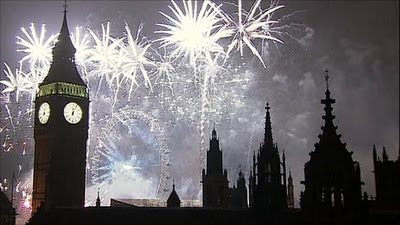
Allendale guisers. - an new take on an old custom?
The term "guiser" is likely derived from the word "disguise" and used widely in English customs, denoting people dressed up to adopt another persona. The Northumbrian town of Allendale has a tradition on 31st December, whereby forty fancy-dressed guisers parade through the streets, carrying barrels of burning pitch on their heads. They are accompanied by a brass band and the ceremony culminates at midnight with a large bonfire lit in the Market Place.
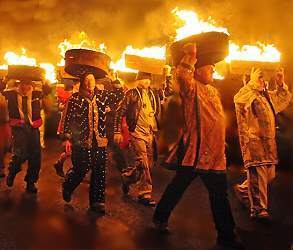
The barrels are cut down to a depth of 12 inches and filled with rags and shavings soaked in paraffin, although originally tar would have been used, and set alight. The more romantic traditionalists say this custom has its roots in ancient fire worship carried out by the Vikings, Celts and Druids - whereas the truth is slightly less exciting!
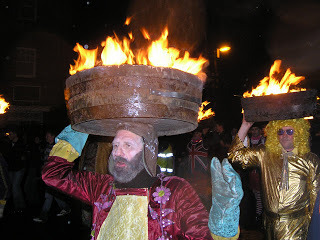
It seems in the mid 1800's someone came up with the idea of burning tar barrels to light the path for the band that traditionally walked the streets on New Years Eve. Nearly a hundred years later, during the second World War, it seems the villagers were so proud of their tradition they were reluctant to stop it when blackouts were imposed.
"When war broke out and many of the guisers were called up for military service, blackout regulations enforced the cancellation of the bonfire. To maintain continuity of the custom, the local carpenter, Launcelot Bell, designed a…small tar barrel which he carried unlit…On the customary site of the bonfire he placed it inside a tin trunk, set fire to it and closed the lid. All the local people then danced around the trunk."
 A New Year's Gathering - the tradition.
A New Year's Gathering - the tradition.The tradition of large crowds of strangers gathering together on New Year's Eve is widespread and most cities have a focal spot where this takes place. In London, the Illustrated London News (1897) records significant numbers collecting outside St Pauls Cathedral to hear the newly installed bells ring in the New Year. All went well for the first few years until the crowds became over large and 'uproarious' and cathedral authorities stopped the New Year bell ringing. Undeterred, the crowds still gathered.
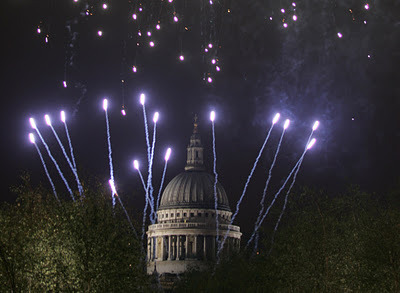 A letter to the Times in 1935 voiced the opinion that there was nothing inherently wrong with mass-gathering but they should be better organised - especially the singing, as recorded below:
A letter to the Times in 1935 voiced the opinion that there was nothing inherently wrong with mass-gathering but they should be better organised - especially the singing, as recorded below: "In England we seldom sing en masse, except at football matches. In this respect our failing on New Year's Ever are particularly deplorable….emotion finds no orderly outlet….Leaderless, they make no united musical effort. Instead, individuals and small groups sing. The strains of a dozen banal and tuneless ditties intermingle depressingly."

So how will you see the New Year in? Any "banal and tuneless ditties" for you…or something altogether more uplifting? Do comment and tell us about your New Year traditions...and dont forget there's a giveaway prize for one lucky person!!
 http://iamareadernotawriter.blogspot.comClick link to full list of blog hop participants.
http://iamareadernotawriter.blogspot.comClick link to full list of blog hop participants.
Published on December 29, 2011 13:06
December 21, 2011
Cancel Christmas!

Yesterday, I finished my Christmas shopping and so, at last, I'm beginning to feel quite festive. Love it or hate, Christmas is going to happen!
But this wasn't always the case.
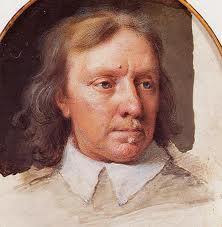 Oliver CromwellIn the mid 17th century, England entered an unstable period of civil war. Statesman and General, Oliver Cromwell led his armies to fight against the monarch, Charles I - and ultimately had the king beheaded. Cromwell's supporters were Puritans, a group who, amongst other things, believed it was their mission to purge the country of decadence.
Oliver CromwellIn the mid 17th century, England entered an unstable period of civil war. Statesman and General, Oliver Cromwell led his armies to fight against the monarch, Charles I - and ultimately had the king beheaded. Cromwell's supporters were Puritans, a group who, amongst other things, believed it was their mission to purge the country of decadence.
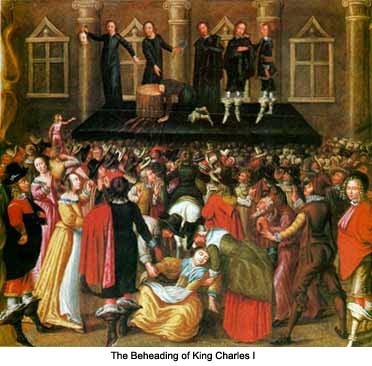 The Puritans believed you would ascend to heaven so long as you lead a blameless life on earth, and with this aim frivolity and excessive behaviour were banned. Woman had to wear a long black dress, white apron and headdress and no makeup. The men required to have short hair and dress head to toe in black. Small wonder then that the heady excesses of Christmas day were frowned upon. December 25th was traditionally a public holiday, businesses closed, people attended church as well as exchanging presents, dancing, singing and drinking. The Puritans saw this as a frenzy of disorder: 'More mischief is that time committed than in all the year besides ... What dicing and carding, what eating and drinking, what banqueting and feasting is then used ... to the great dishonour of God and the impoverishing of the realm.' Philip Stubbes.
The Puritans believed you would ascend to heaven so long as you lead a blameless life on earth, and with this aim frivolity and excessive behaviour were banned. Woman had to wear a long black dress, white apron and headdress and no makeup. The men required to have short hair and dress head to toe in black. Small wonder then that the heady excesses of Christmas day were frowned upon. December 25th was traditionally a public holiday, businesses closed, people attended church as well as exchanging presents, dancing, singing and drinking. The Puritans saw this as a frenzy of disorder: 'More mischief is that time committed than in all the year besides ... What dicing and carding, what eating and drinking, what banqueting and feasting is then used ... to the great dishonour of God and the impoverishing of the realm.' Philip Stubbes.

On 8 June 1647, Protestant Puritans were in power and passed, "An Ordinance for Abolishing of Festivals." - You guessed it! They cancelled Christmas."Ordained, by the Lords and Commons in Parliament assembled, that the said Feast of the nativity of Christ, Easter and Whitsuntide, and all other festival days commonly known at Holy-days be no longer observed …within the Kingdom of England and Dominion of Wales."
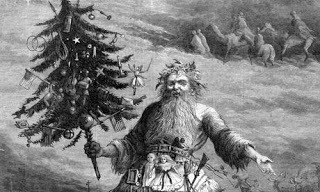 Olde Father Christmas.Predictably, this was an unpopular move with the majority and the fate of Christmas became a rallying cry. "Old Father Christmas" became spokesman for those opposed to the new law and pamphlets soon appeared with his jollity contrasted against the gloomy piety of the Puritans.
Olde Father Christmas.Predictably, this was an unpopular move with the majority and the fate of Christmas became a rallying cry. "Old Father Christmas" became spokesman for those opposed to the new law and pamphlets soon appeared with his jollity contrasted against the gloomy piety of the Puritans.
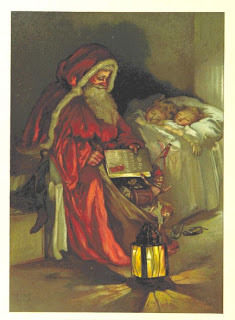 People rebelled in their own way - some refused to open their shops on December 25th, others continued to cook a special roast meal and others attended secret services - although not always without consequences. "I went with my wife to London to celebrate Christmas Day. Mr Gunning preaching in Exeter Chapel…as he was giving us the holy Sacrament, the chapel was surrounded with soldiers…"John Evelyn 25 December 1657.
People rebelled in their own way - some refused to open their shops on December 25th, others continued to cook a special roast meal and others attended secret services - although not always without consequences. "I went with my wife to London to celebrate Christmas Day. Mr Gunning preaching in Exeter Chapel…as he was giving us the holy Sacrament, the chapel was surrounded with soldiers…"John Evelyn 25 December 1657.
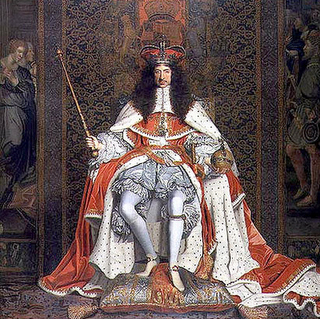 Charles II.The Puritan campaign against Christmas lasted until 1660 when it was swept aside by the Restoration and the fun-loving Charles II.So whatever your opinion on the excesses of Christmas, just be glad we live in times where we have the option to celebrate!
Charles II.The Puritan campaign against Christmas lasted until 1660 when it was swept aside by the Restoration and the fun-loving Charles II.So whatever your opinion on the excesses of Christmas, just be glad we live in times where we have the option to celebrate! 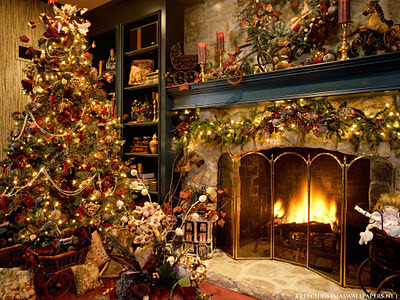
WISHING YOU ALL A HAPPY, HEALTHY AND CONTENTED CHRISTMAS.
Grace x
Published on December 21, 2011 08:19
December 14, 2011
'Twas The Night Before Christmas.

"Twas the night before Christmas, when all through the house, Not a creature was stirring, not even a mouse." Clement Clark Moore (1779 - 1863)
 Welcome!
Welcome! At this stop on the Virtual Advent Tour, to get you in the Christmas spirit I'm posting about some of the traditions surrounding Christmas Eve.
In modern times it seems Christmas decorations go up as soon as the Halloween ones come down, but this would have been unheard of for our great-grandparents. In their day it was considered unlucky to decorate the house before Christmas Eve and a busy time was had by all putting up greenery and trimming the tree, buying in fresh food (there were no fridges or freezers!) and visiting church. Holly, mistletoe and pine were the most popular decortaions.The Victorians are widely attributed with the introduction of kissing under the mistletoe, but in fact the tradition dates back to the 16th century. An interesting but little known twist to the mistletoe tradition is:"… once kissed under the mistletoe should be burnt, or those couples who kissed beneath it would be foes for the rest of the year."

It was said that any girl NOT kissed under the mistletoe would not be kissed in the forthcoming year, and to put mistletoe under a young woman's pillow would cause her to dream of her future husband. Incidentally, any holly brought into the house at any time other than Christmas was believed to result in death.
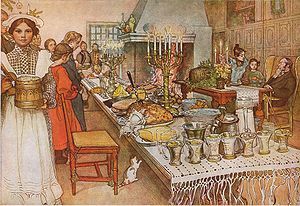 A table being readied with Christmas fare.For farmers, Christmas Eve was a time to give extra food to the animals - not just as a treat, but in the hope that they needed less attention on Christmas day itself. In the 18th and 19th centuries, Christmas eve was also a popular time for traditional 'performers' to visit, such as carol singers, or sword dancers (if you lived in North East England), the Hooden Horse (a Kentish tradition) or guise dancers (a Cornish tradition) Not only were the performers likely to find people at home but they would likely be filled with good cheer, and even if no money was forthcoming, they would likely welcome strangers with food and drink.
A table being readied with Christmas fare.For farmers, Christmas Eve was a time to give extra food to the animals - not just as a treat, but in the hope that they needed less attention on Christmas day itself. In the 18th and 19th centuries, Christmas eve was also a popular time for traditional 'performers' to visit, such as carol singers, or sword dancers (if you lived in North East England), the Hooden Horse (a Kentish tradition) or guise dancers (a Cornish tradition) Not only were the performers likely to find people at home but they would likely be filled with good cheer, and even if no money was forthcoming, they would likely welcome strangers with food and drink. 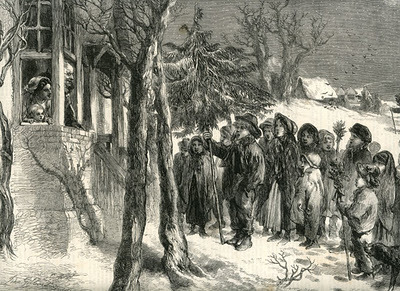
The Gentleman's Magazine of 1824 records some Christmas Eve celebrations in Yorkshire."At eight o'clock in the evening, the bells greet 'old Father Christmas' with a merry peal. The children parade the streets wth drums, trumpets, bells or…even a poker and a shovel, taken from the humble cottage fire." Christmas Eve was also said to be a good night for an unmarried woman to divine the identity of her future husband. Apparently this good time to meddle in the dark arts because ghosts and other spirits were said to be powerless on this night. The method of doing this was recorded by Sidney Addy in 1890."If a girl walk backwards to a pear tree, on Christmas Eve and walk around the tree three times, she will see an image of her future husband."And finally, at the midnight hour church bells would ring and many people would open their doors to welcome Christmas in. It was said that on the stroke of midnight cattle would kneel down in their stalls and bees hum the Old Hundreth Psalm in their hives.
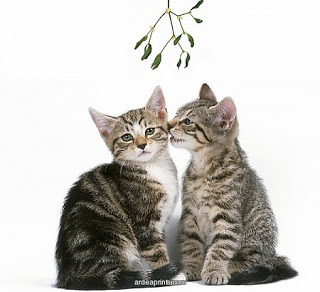
Do you have any Christmas Eve traditions - do leave a comment and share them.
Published on December 14, 2011 08:25
December 7, 2011
Monumental Vertigo!
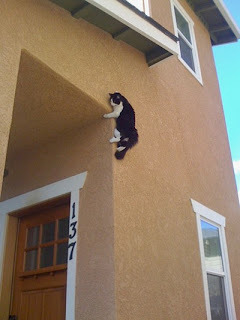
I'm not good with heights - in fact, that's something of an understatement. The number of historical buildings that I have exited on my bottom, for fear of open staircases and exposed battlements is a long one. Numbered amongst these is The Monument in London - but for once it seems I am in good company.
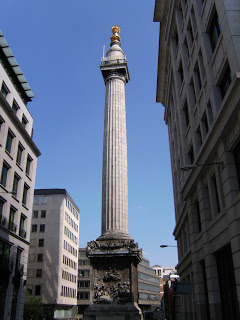
James Boswell, writer, visited The Monument in 1762. Half way up the 311 stone steps he suffered a panic attack (can't say I blame him. The Monument feels like a tall stone tomb inside with a dizzying spiral staircase - I got less than half way before I froze and could go neither up nor down - stuck against the wall while people pushed past…but that's another story.) Boswell did better than me and overcame his fear to reach the top to see what was to be seen from what was in the 18th Century the highest viewpoint in London.
His opinion was less than glowing:"Horrid to be so monstrous a way up in the air, so far above London and all its spires."A rash of suicides meant the viewing platform was caged in 1842.
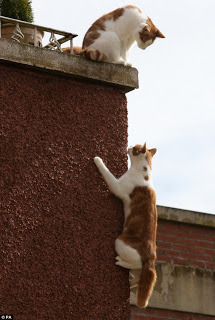
So what is the Monument?
As well as being the tallest isolated stone column in the world, at 202 feet. It stands as tall as it does distant from the start of the Great Fire of London, in a baker's shop in Pudding Lane, 2 September 1666. Built on the site of St. Margaret's Church (the first church to be destroyed in the fire), Fish Street, it commemorates the Great Fire.Designed by Sir Christopher Wren (designer of St. Paul's Cathedral) and Robert Hooke, Wren wanted to put a statue of King Charles II at the top. But king declined pointing out:
"I didn't start the fire."Instead, a flaming urn of gilt bronze placed on the summit.
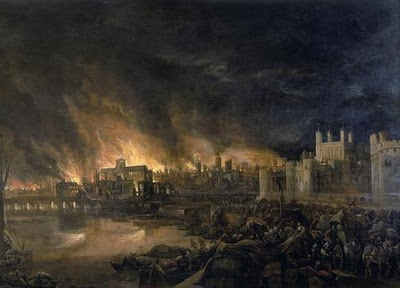
During the Great Fire itself surprising few lives were lost but 13,000 homes destroyed and great swathes of London raised to the ground. However, the damage was more extensive than necessary because superstitious people refused to fight the fire, Charles Mackay explains in his 1841 collection, Extraordinary Popular Delusions and quotes from eye-witness accounts:
"The writer, who accompanied the Duke of York….through the district between Fleet-bridge and the Thames, states that their efforts to check the progress of the flames…were much impeded by the superstition of the people."
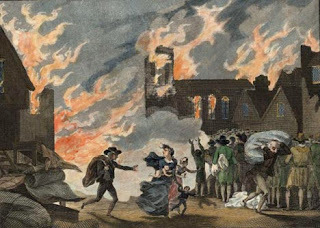
It appears there was a widely held belief at the time that Mother Shipton prophesied that:"London in sixty-six will be burnt to ashes."
Those that should have known better even convinced others to do nothing. "A son of the noted Sir Kenelm Digby…persuaded them that no power on earth could prevent the fulfilment of the prediction, for it was written…that London was to be destroyed."
So people stood back and watched, instead of acting to prevent the disaster.
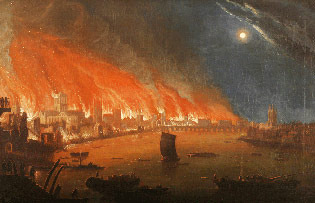
"Hundreds of person, who might have rendered valuable assistance and saved whole parishes from devastation, folded their arms and looked on. As man …with less compunction, gave themselves up to plunder the city." Charles Mackay.
So finally, harking back to my abortive attempt to climb the Monument, who else has had an embarrassing experience in a public place?
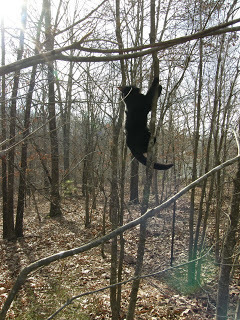
Published on December 07, 2011 06:57
'Familiar Felines.'
Following on from last weeks Halloween posting, today's blog post looks at the unwanted image of cats as the witches familiar - from the Norse Goddess Freya to lonely women in the middle ages.
The full Following on from last weeks Halloween posting, today's blog post looks at the unwanted image of cats as the witches familiar - from the Norse Goddess Freya to lonely women in the middle ages.
The full post can found at:
http://graceelliot-author.blogspot.com
...more
The full Following on from last weeks Halloween posting, today's blog post looks at the unwanted image of cats as the witches familiar - from the Norse Goddess Freya to lonely women in the middle ages.
The full post can found at:
http://graceelliot-author.blogspot.com
...more
- Grace Elliot's profile
- 156 followers



